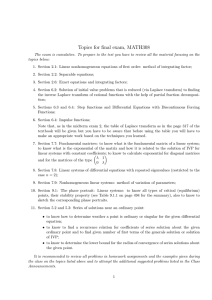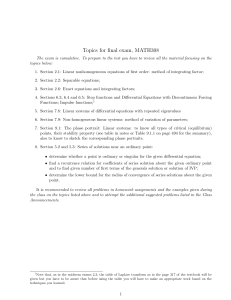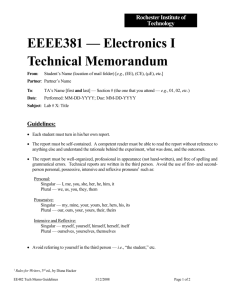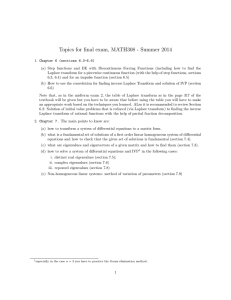Ordinary Differential Equations Dr. Marco A Roque Sol 12/01/2015
advertisement
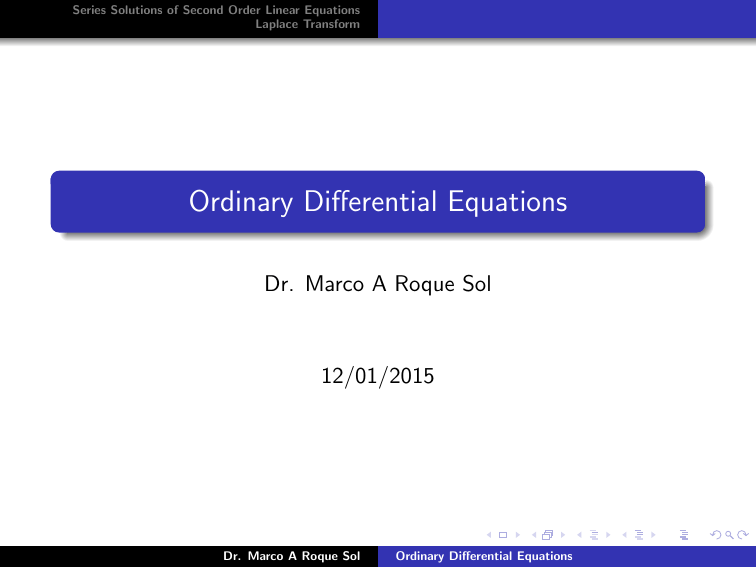
Series Solutions of Second Order Linear Equations
Laplace Transform
Ordinary Differential Equations
Dr. Marco A Roque Sol
12/01/2015
Dr. Marco A Roque Sol
Ordinary Differential Equations
Series Solutions of Second Order Linear Equations
Laplace Transform
Series Solutions Near a Regular Singular Point, Part I
Series Solutions Near a Regular Singular Point, Part II
Series Solutions Near a Regular Singular Point, Part
I
However, just as an Euler equation may not have two solutions of
the form y = x r , so a more general equation with a regular
singular point may not have two solutions of the form mentioned
above.
In particular, we can show that if the roots r1 and r2 of the indicial
equation are equal or differ by an integer, then the second solution
normally has a more complicated structure.
If the roots of the indicial equation are complex, there are always
two solutions of the form mentioned above. Of course, these
solutions are complex-valued functions of x.
Dr. Marco A Roque Sol
Ordinary Differential Equations
Series Solutions of Second Order Linear Equations
Laplace Transform
Series Solutions Near a Regular Singular Point, Part I
Series Solutions Near a Regular Singular Point, Part II
Series Solutions Near a Regular Singular Point, Part
II
Now let us consider the general problem of determining a solution
of the equation
L[y ] = x 2 y 00 + x[xp(x)]y 0 + [x 2 q(x)]y = 0
where
xp(x) =
∞
X
pn x n ,
n=0
x 2 q(x) =
∞
X
qn x n ,
n=0
and both series converge in an interval |x| < ρ for some ρ > 0.
The point x = 0 is a regular singular point, and the corresponding
Euler equation is
x 2 y 00 + p0 xy 0 + q0 y = 0
Dr. Marco A Roque Sol
Ordinary Differential Equations
Series Solutions of Second Order Linear Equations
Laplace Transform
Series Solutions Near a Regular Singular Point, Part I
Series Solutions Near a Regular Singular Point, Part II
Series Solutions Near a Regular Singular Point, Part
II
We seek a solution for x > 0 and assume that it has the form
φ(r , x) = x r
∞
X
an x n ,
n=0
=
∞
X
an x r +n
n=0
where a0 6= 0, and we have written y = φ(r , x) to emphasize that
φ depends on r as well as x. It follows that
y0 =
∞
X
an (r + n)x r +n−1 ;
y 00 =
n=0
∞
X
an (r + n)(r + n − 1)x r +n−2
n=0
Dr. Marco A Roque Sol
Ordinary Differential Equations
Series Solutions of Second Order Linear Equations
Laplace Transform
Series Solutions Near a Regular Singular Point, Part I
Series Solutions Near a Regular Singular Point, Part II
Series Solutions Near a Regular Singular Point, Part
II
Then, substituting y , y 0 , and y 00 in the ODE, and doing some
algebra, we obtain
r
L[φ] = a0 F (r )x +
∞
X
"
F (r + n)an +
n=0
∞
X
#
ak [(r + k)pn−k + qn−k ] x r +n
n=0
where
F (r ) = r (r − 1) + p0 r + q0
Dr. Marco A Roque Sol
Ordinary Differential Equations
Series Solutions of Second Order Linear Equations
Laplace Transform
Series Solutions Near a Regular Singular Point, Part I
Series Solutions Near a Regular Singular Point, Part II
Series Solutions Near a Regular Singular Point, Part
II
The coefficient of each power of x must be zero. Since a0 6= 0, the
term involving x r yields the equation F (r ) = 0. This equation is
called the indicial equation; note that it is exactly the equation
we would obtain in looking for solutions y = x r of the Euler
equation associated to the ODE.
The roots r1 and r2 , of the indicial equation, are called the
exponents at the singularity, they determine the qualitative
nature of the solution in the neighborhood of the singular point.
Setting the coefficient of x r +n equal to zero gives the recurrence
relation
∞
X
F (r + n)an +
ak [(r + k)pn−k + qn−k ] = 0; n ≥ 1.
n=0
Dr. Marco A Roque Sol
Ordinary Differential Equations
Series Solutions of Second Order Linear Equations
Laplace Transform
Series Solutions Near a Regular Singular Point, Part I
Series Solutions Near a Regular Singular Point, Part II
Series Solutions Near a Regular Singular Point, Part
II
This equation shows that, in general, an depends on the value of r
and all the preceding coefficients a0 , a1 , ..., an−1 . It also shows that
we can successively compute a1 , a2 , ..., an , ... in terms of a0 and the
coefficients in the series for xp(x) and x 2 q(x), provided that
F (r + 1), F (r + 2), ..., F (r + n), ... are not zero.
The only values of r for which F (r ) = 0 are r = r1 and r = r2 ;
since r1 ≥ r2 , it follows that r1 + n is not equal to r1 or r2 for
n ≥ 1. Consequently, F (r1 + n) 6= 0 for n ≥ 1. Hence we can
always determine one solution of the form
"
#
∞
X
y1 = x r1 1 +
an (r1 )x n ; x > 0
n=1
Dr. Marco A Roque Sol
Ordinary Differential Equations
Series Solutions of Second Order Linear Equations
Laplace Transform
Series Solutions Near a Regular Singular Point, Part I
Series Solutions Near a Regular Singular Point, Part II
Series Solutions Near a Regular Singular Point, Part
II
Here we have introduced the notation an (r1 ) to indicate that an
has been determined from the recurrence relation, with r = r1 .
If r2 is not equal to r1 , and r1 − r2 is not a positive integer, then
r2 + n is not equal to r1 for any value of n ≥ 1; hence
F (r2 + n) 6= 0, and we can also obtain a second solution
"
#
∞
X
y2 = x r2 1 +
an (r2 )x n ; x > 0
n=1
It can be shown that (y1 , y2 ) form a fundamental solution in the
general solution is given by
y (x) = c1 y1 (x) + c2 y2 (x)
Dr. Marco A Roque Sol
Ordinary Differential Equations
Series Solutions of Second Order Linear Equations
Laplace Transform
Series Solutions Near a Regular Singular Point, Part I
Series Solutions Near a Regular Singular Point, Part II
Series Solutions Near a Regular Singular Point, Part
II
Just as for the series solutions about ordinary points, the series
above converge at least in the interval |x| < ρ where the series for
both xp(x) and x 2 q(x) converge.
It is important to realize that r1 and r2 , the exponents at the
singular points are the solution of the indicial equation
F (r ) = r (r − 1) + p0 r + q0 = 0
whose coefficients are given by
p0 = lim xp(x);
x→0
Dr. Marco A Roque Sol
q0 = lim x 2 q(x)
x→0
Ordinary Differential Equations
Series Solutions of Second Order Linear Equations
Laplace Transform
Series Solutions Near a Regular Singular Point, Part I
Series Solutions Near a Regular Singular Point, Part II
Series Solutions Near a Regular Singular Point, Part
II
Example 5.18
Discuss the nature of the solutions of the equation
2x(1 + x)y 00 + (3 + x)y 0 − xy = 0
near the singular points.
Solution
In this case P(x) = 2x(1 + x), Q(x) = 3 + x, and R(x) = −x. The
points x = 0 and x = −1 are the only singular points. The point
x = 0 is a regular singular point, since
limx→0 x
Q(x)
3 + (1 + x)
3
= limx→0 x
=
P(x)
2x(1 + x)
2
Dr. Marco A Roque Sol
Ordinary Differential Equations
Series Solutions of Second Order Linear Equations
Laplace Transform
Series Solutions Near a Regular Singular Point, Part I
Series Solutions Near a Regular Singular Point, Part II
Series Solutions Near a Regular Singular Point, Part
II
limx→0 x 2
R(x)
−x
= limx→0 x 2
=0
P(x)
2x(1 + x)
Further, p0 = 3/2, and q0 = 0. Thus the indicial equation is
3
r (r − 1) + r = 0
2
and the roots are r1 = 0, r2 = −1/2 . Since these roots are not
equal and do not differ by an integer, there are two solutions of the
form
y1 = 1 +
∞
X
"
n
an (0)x ;
−1/2
y2 = |x|
n=1
1+
∞
X
#
an (−1/2)x
n=1
Dr. Marco A Roque Sol
Ordinary Differential Equations
n
Series Solutions of Second Order Linear Equations
Laplace Transform
Series Solutions Near a Regular Singular Point, Part I
Series Solutions Near a Regular Singular Point, Part II
Series Solutions Near a Regular Singular Point, Part
II
for 0 < |x| < ρ. To get a lower bound for ρ, remember that the
distance between x = 0 and x = −1, the two singularities, is 1,
and that is exactly the lower bound for ρ
The point x = −1 is a regular singular point, since
limx→−1 (x + 1)
Q(x)
(x + 1)(3 + x)
= limx→−1
= −1
P(x)
2x(1 + x)
limx→−1 (x + 1)2
(x + 1)2 (−x)
R(x)
= limx→−1
=0
P(x)
2x(1 + x)
In this case, p0 = −1 and q0 = 0. Thus the indicial equation is
Dr. Marco A Roque Sol
Ordinary Differential Equations
Series Solutions of Second Order Linear Equations
Laplace Transform
Series Solutions Near a Regular Singular Point, Part I
Series Solutions Near a Regular Singular Point, Part II
Series Solutions Near a Regular Singular Point, Part
II
r (r − 1) − r = 0
and the roots are r1 = 2, r2 = 0 . Since these roots are not equal
and do not differ by an integer, corresponding to the larger root
there is a solution of the form
"
#
∞
X
y1 = (x + 1)2 1 +
an (2)(x + 1)n
n=1
The series converges at least for |x + 1| < 1, and y1 is an analytic
function there. Since the two roots differ by a positive integer,
there may or may not be a second solution of the form
Dr. Marco A Roque Sol
Ordinary Differential Equations
Series Solutions of Second Order Linear Equations
Laplace Transform
Series Solutions Near a Regular Singular Point, Part I
Series Solutions Near a Regular Singular Point, Part II
Series Solutions Near a Regular Singular Point, Part
II
y2 = 1 +
"∞
X
#
an (0)(x + 1)n
n=1
Thus, that we have two cases for analisis, namely,
Equal Roots
In this case, we consider r to be a continuous variable and
determine an as a function of r by solving the recurrence relation.
F (r + n)an +
∞
X
ak [(r + k)pn−k + qn−k ] = 0;
n=0
Dr. Marco A Roque Sol
Ordinary Differential Equations
n ≥ 1.
Series Solutions of Second Order Linear Equations
Laplace Transform
Series Solutions Near a Regular Singular Point, Part I
Series Solutions Near a Regular Singular Point, Part II
Series Solutions Near a Regular Singular Point, Part
II
For this choice of an (r ) for n ≥ 1, the terms involving
x r +1 , x r +2 , x r +3 , ... all have coefficients equal to zero. Therefore,
the equation
r
L[φ] = a0 F (r )x +
∞
X
"
F (r + n)an +
n=0
∞
X
#
ak [(r + k)pn−k + qn−k ] x r +n
n=0
reduces to
L[φ](r , x) = a0 F (r )x r = a0 (r − r1 )2 x r
Dr. Marco A Roque Sol
Ordinary Differential Equations
Series Solutions of Second Order Linear Equations
Laplace Transform
Series Solutions Near a Regular Singular Point, Part I
Series Solutions Near a Regular Singular Point, Part II
Series Solutions Near a Regular Singular Point, Part
II
since r1 is a repeated root of F (r ). Therefore
L[φ](r1 , x) = a0 F (r1 )x r1 = a0 (r1 − r1 )2 x r1 = 0
hence, as we already know, y1 (x) given by
"
#
∞
X
2
n
y1 = (x + 1) 1 +
an (2)(x + 1)
n=1
is one solution. Morevoer,
Dr. Marco A Roque Sol
Ordinary Differential Equations
Series Solutions of Second Order Linear Equations
Laplace Transform
Series Solutions Near a Regular Singular Point, Part I
Series Solutions Near a Regular Singular Point, Part II
Series Solutions Near a Regular Singular Point, Part
II
∂φ
∂ L
(r , x) = a0
(r − r1 )2 x r = a0 (r − r1 )2 x r lnx + 2(r − r1 )x r
∂r
∂r
∂φ
(r1 , x) = 0
L
∂r
Hence, a second solution is
∂φ(r , x)
∂
y2 (x) =
(r1 , x) =
∂r
∂r
"
r1
y2 (x) = x ln(x) a0 +
∞
X
"
x r + a0 +
an (r )x
Dr. Marco A Roque Sol
#!
an (r )x n
n=1
#
n=1
∞
X
n
+ x r1
∞
X
an0 (r1 )x n ; x > 0
n=1
Ordinary Differential Equations
Series Solutions of Second Order Linear Equations
Laplace Transform
Series Solutions Near a Regular Singular Point, Part I
Series Solutions Near a Regular Singular Point, Part II
Series Solutions Near a Regular Singular Point, Part
II
y2 (x) = y1 (x)ln(x) + x r1
∞
X
an0 (r1 )x n ; x > 0
n=1
where an0 (r1 ) denotes dan /dr evaluated at r = r1 .
A second possibility is simply to assume that y2 has the form
y2 (x) = y1 (x)ln(x) + x r1
∞
X
bn (r1 )x n ; x > 0
n=1
The coefficients bn are calculated, as usual, by substituting into
the differential equation, collecting terms, and setting the
coefficient of each power of x equal to zero.
Dr. Marco A Roque Sol
Ordinary Differential Equations
Series Solutions of Second Order Linear Equations
Laplace Transform
Series Solutions Near a Regular Singular Point, Part I
Series Solutions Near a Regular Singular Point, Part II
Series Solutions Near a Regular Singular Point, Part
II
A third possibility is to use the method of reduction of order to
find y2 (x) once y1 (x)
Roots r1 and r2 Differing by an Integer N .
In this case the derivation of the second solution is considerably
more complicated and it is beyond the scope of this class.
However, we have the following theorem.
Dr. Marco A Roque Sol
Ordinary Differential Equations
Series Solutions of Second Order Linear Equations
Laplace Transform
Series Solutions Near a Regular Singular Point, Part I
Series Solutions Near a Regular Singular Point, Part II
Series Solutions Near a Regular Singular Point, Part
II
Theorem 5.3
Consider the differential equation
x 2 y 00 + x[xp(x)]y 0 + [x 2 q(x)]y = 0
where x = 0 is a regular singular point. Then xp(x) and x 2 q(x)
are analytic at x = 0 with convergent power series expansions
xp(x) =
∞
X
pn x n ;
n=1
x 2 q(x) =
∞
X
qn x n ;
n=1
for |x| < ρ, where ρ > 0, is the minimum of the radii of
convergence of the power series for xp(x) and x 2 q(x).
Dr. Marco A Roque Sol
Ordinary Differential Equations
Series Solutions of Second Order Linear Equations
Laplace Transform
Series Solutions Near a Regular Singular Point, Part I
Series Solutions Near a Regular Singular Point, Part II
Series Solutions Near a Regular Singular Point, Part
II
Let r1 and r2 be the roots of the indicial equation
r (r − 1) + p0 r + q0 = 0
with r1 ≥ r2 if r1 and r2 are real. Then in either the interval
−ρ < x < 0 or the interval 0 < x < ρ, there exists a solution of
the form
"
#
∞
X
r1
n
y1 = |x| 1 +
an (r1 )x
n=1
where the an (r1 ) are given by the recurrence relation
F (r + n)an +
∞
X
ak [(r + k)pn−k + qn−k ] = 0;
n=0
Dr. Marco A Roque Sol
Ordinary Differential Equations
n ≥ 1.
Series Solutions of Second Order Linear Equations
Laplace Transform
Series Solutions Near a Regular Singular Point, Part I
Series Solutions Near a Regular Singular Point, Part II
Series Solutions Near a Regular Singular Point, Part
II
with a0 = 1 and r = r1 . If r1 − r2 is not zero or a positive integer,
then in either the interval −ρ < x < 0 or the interval 0 < x < ρ,
there exists a second solution of the form
"
#
∞
X
y2 = |x|r2 1 +
an (r2 )x n
n=1
The an (r2 ) are also determined by the recurrence relation
mentioned above with a0 = 1 and r = r2 . The power series
obtained before converge at least for |x| < ρ.
If r1 = r2 , then the second solution is
"
y2 = y1 (x)ln|x| + |x|r1 1 +
∞
X
#
bn (r1 )x n
n=1
Dr. Marco A Roque Sol
Ordinary Differential Equations
Series Solutions of Second Order Linear Equations
Laplace Transform
Series Solutions Near a Regular Singular Point, Part I
Series Solutions Near a Regular Singular Point, Part II
Series Solutions Near a Regular Singular Point, Part
II
If r1 − r2 = N, a positive integer, then the second solution is
"
#
∞
X
r2
n
y2 = ay1 (x)ln|x| + |x| 1 +
cn (r2 )x
n=1
The coefficients an (r1 ), bn (r1 ), cn (r2 ), and the constant a can be
determined either by substituting the form of the series solutions
for y in the ODE or by the formulas related to y1 (x)
P∞
ak [(r + k)pn−k + qn−k ]
an = − n=0
; bn (r1 ) = an0 (r1 );
F (r + n)
cn (r2 ) =
d
[(r − r2 )an (r )]
;
dr
r =r2
Dr. Marco A Roque Sol
a = limr →r2 (r − r2 )aN (r )
Ordinary Differential Equations
Series Solutions of Second Order Linear Equations
Laplace Transform
Series Solutions Near a Regular Singular Point, Part I
Series Solutions Near a Regular Singular Point, Part II
Series Solutions Near a Regular Singular Point, Part
II
where an (r ) is determined from the recurrence relation with
a0 = 1. If aN (r2 ) is finite, then a = 0 and there is no logarithmic
term in y2 .
Each of the series, y1 (x) and y2 (x) converges at least for |x| < ρ
and defines a function that is analytic in some neighborhood of
x = 0. In all three cases, the two solutions y1 (x) and y2 (x) form a
fundamental set of solutions of the given differential equation.
Dr. Marco A Roque Sol
Ordinary Differential Equations
Series Solutions of Second Order Linear Equations
Laplace Transform
Series Solutions Near a Regular Singular Point, Part I
Series Solutions Near a Regular Singular Point, Part II
Series Solutions Near a Regular Singular Point, Part
II
Dr. Marco A Roque Sol
Ordinary Differential Equations
Series Solutions of Second Order Linear Equations
Laplace Transform
Definition of The Laplace Transform
Definition of The Laplace Transform
Laplace Transform
Among the tools that are very useful for solving linear differential
equations are integral transforms. An integral transform is a
relation of the form
Z
β
F (s) =
K (s, t)f (t)dt
α
where K (s, t) is a given function, called the kernel of the
transformation, and the limits of integration α and β are also
given. It is possible that α = −∞ or β = ∞ or both. The relation,
introduced above, transforms the function f into another function
F , which is called the transform of f .
Dr. Marco A Roque Sol
Ordinary Differential Equations
Series Solutions of Second Order Linear Equations
Laplace Transform
Definition of The Laplace Transform
Definition of The Laplace Transform
There are several integral transforms that are useful in applied
mathematics, but we consider only the Laplace Transform (
https://en.wikipedia.org/wiki/Pierre-Simon_Laplace )
(... Napoleon asked Laplace where God fit into his mathematical
work ” Traite de mecanique celeste ”, and Laplace famously replied
”Sir, I have no need of that hypothesis ”... ).
Laplace Transform
Let f (t) be given for t ≥ 0. Then the Laplace transform of f ,
which we will denote by L {f (t)} = F (s), is defined by the
equation
Z ∞
e −st f (t)dt
L {f (t)} = F (s) =
0
whenever this improper integral converges.
Dr. Marco A Roque Sol
Ordinary Differential Equations

